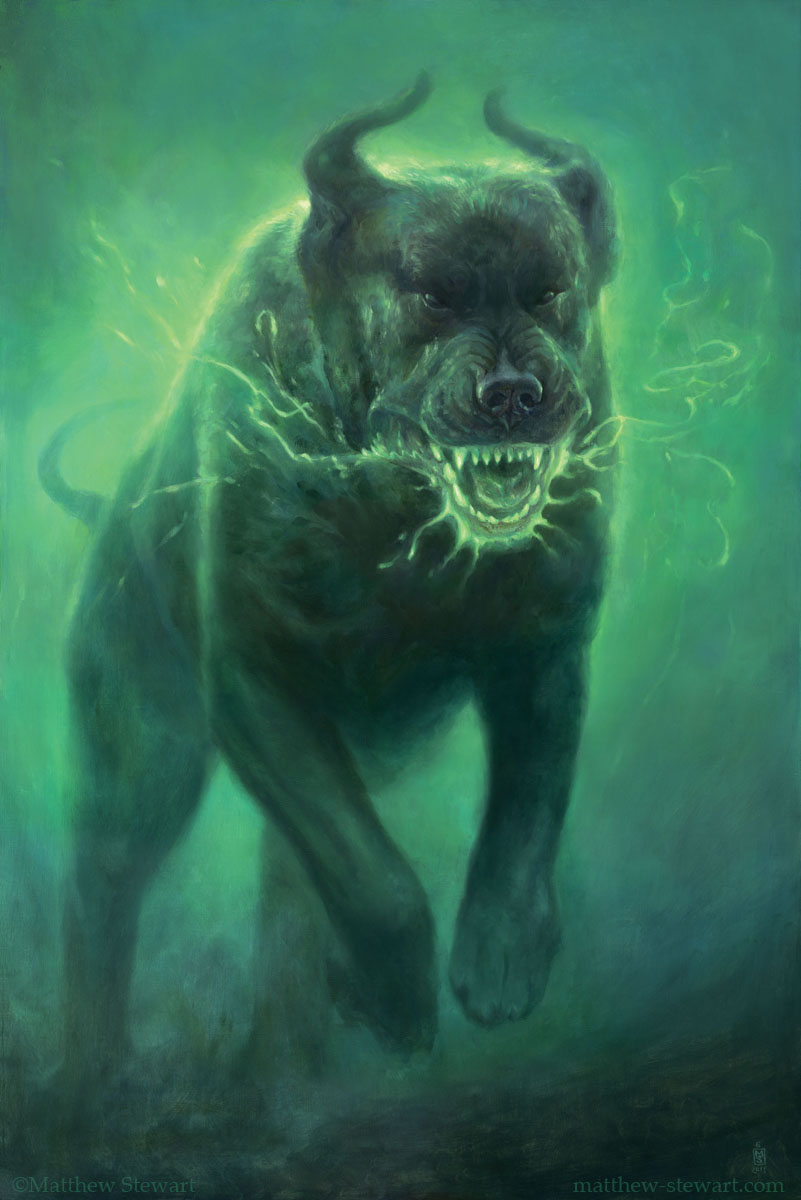Arthur Conan Doyle
1902
(The scientific minds of Holmes and Watson are tested by howls on the moor, the legend of a fiery hell-hound, and a giant pawprint next to a dead nobleman.)

A novel-length Sherlock Holmes mystery! The readers of the Strand Magazine must have been delighted. They must have vigorously discussed with each other the prospects of the case between installments. Releasing a detective story by degrees has got to be risky, since the readers have so much time to figure everything out. There are enough threads interwoven in this story, though, and enough minor details that must be incorporated into a solution, that I suspect almost everyone will be surprised at something in the denouement. Besides, we would need a healthy dose of luck to solve the riddle ourselves, for there are crucial elements about which we can only guess during the narration. These are revealed to us only after Holmes has discovered them and solved the case in his mind. In this way, Doyle all but ensures that competition with the sleuth is beyond our grasp.
Although the most haunting aspect of the typical Sherlock Holmes case is nothing more than the dense fog of pipe smoke around the detective’s chair, Doyle did have an interest in spiritualism, and wrote a few books on the subject. In The Hound of the Baskervilles he combines these two interests by infusing the tale with a strong atmosphere of macabre otherworldliness. Probably more than the facts of the case or its solution, the damp darkness and chilling moans of the moor are likely to remain with us long after we have finished reading the book.
 The story begins on Baker Street in London, with a competition between Holmes and his foil and assistant Dr. Watson. They surmise the identity of a man who left his walking stick in the foyer while the detective was away. Holmes soundly defeats Watson with that perspicacity and, one must admit, arrogance for which he is known (or, in Watson’s words, “his own masterful nature, which loved to dominate and surprise those who were around him” (ch.14.)). Eventually Dr. Mortimer (the owner of the stick) returns and tells them of a legendary “Curse of the Baskervilles”, according to which a hell-hound is responsible for the death of every Baskerville that attempts to take up residence in Baskerville Hall somewhere in Devon. The most recent death has brought Dr. Mortimer to Holmes; for near the body of Sir Charles Baskerville (who apparently died of a heart attack) was a gigantic dog’s pawprint.
The story begins on Baker Street in London, with a competition between Holmes and his foil and assistant Dr. Watson. They surmise the identity of a man who left his walking stick in the foyer while the detective was away. Holmes soundly defeats Watson with that perspicacity and, one must admit, arrogance for which he is known (or, in Watson’s words, “his own masterful nature, which loved to dominate and surprise those who were around him” (ch.14.)). Eventually Dr. Mortimer (the owner of the stick) returns and tells them of a legendary “Curse of the Baskervilles”, according to which a hell-hound is responsible for the death of every Baskerville that attempts to take up residence in Baskerville Hall somewhere in Devon. The most recent death has brought Dr. Mortimer to Holmes; for near the body of Sir Charles Baskerville (who apparently died of a heart attack) was a gigantic dog’s pawprint.
The next of kin would have been a Sir Roger Baskerville, but he had already died in the tropics. So a Sir Henry arrives in London from Canada to take up his inheritance. Sir Henry is being followed, and is also warned of danger ahead, but determines not to be frightened away from his estate. Holmes sends Watson with Sir Henry to start researching the case on site. A cast of characters (and suspects) emerges, including the reticent butler Barrymore and his wife, an eccentric naturalist Stapleton and his beautiful but anxious sister, a local busybody Frankland, a friend of the family Mrs. Laura Lyons, an escaped convict Selden who roams the moor, and the often heard and seldom seen apparition of a huge fiery hound. Watson sends reports of his progress to Holmes as he gains information and intimacy with the neighbors, and struggles to retain a rational approach to the crime as the suspicion that something supernatural is at work creeps upon him. Eventually Holmes’s own research leads to a breakthrough, and the project then turns to the gathering of evidence.
In the end Holmes (recklessly, perhaps even unbelievably) places Sir Henry in danger to coax the killer to make a move that will allow the detectives to catch X in the act. The hell-hound is finally met in all its horrific savagery. A final chapter recaps and ties up loose ends in that satisfying, clear manner that tends to elicit many a nod and “oh! of course” in the reader. Who is that X? What is that hell-hound? Well, here I’ll let that remain a mystery! For those looking to remember the ending of a book once read (as I was– I had read it in high school and had forgotten it), here are a couple of hints. The dead Sir Roger Baskerville had a schoolteacher son who married a Caribbean woman. And the letter P proves to be a crucial element in the case!
Tidbits of Significance
Mr. Sherlock Holmes, who was usually very late in the mornings, save upon those not infrequent occasions when he was up all night, was seated at the breakfast table.
–first sentence, ch. 1.
“Some people without possessing genius have a remarkable power of stimulating it.”
-Holmes to Watson, ch.1.
I knew that seclusion and solitude were very necessary for my friend in those hours of intense mental concentration during which he weighed every particle of evidence, constructed alternative theories, balanced one against the other, and made up his mind as to which points were essential and which immaterial.
-ch.3.
The world is full of obvious things which nobody by any chance ever observes.
-ch.3.
“Of course, if Dr. Mortimer’s surmise should be correct, and we are dealing with forces outside the ordinary laws of Nature, there is an end of our investigation. But we are bound to exhaust all other hypotheses before falling back upon this one.”
-Holmes, ch.3.
“There is nothing more stimulating than a case where everything goes against you.”
-Holmes, ch.5.
“…avoid the moor in those hours of darkness when the powers of evil are exalted.”
-Holmes, after the Baskerville legend, ch.6.
A long, low moan, indescribably sad, swept over the moor. It filled the whole air, and yet it was impossible to say whence it came. From a dull murmur it swelled into a deep roar, and then sank back into a melancholy, throbbing murmur once again.
-ch.7.
“As long as I have my trousers I have a hip-pocket, and as long as I have my hip-pocket I have something in it.”
-Detective Lestrade, in answer to Holmes’s inquiry as to whether he had a gun, ch.14.
A hound it was, an enormous coal-black hound, but not such a hound as mortal eyes have ever seen. Fire burst from its open mouth, its eyes glowed with a smouldering glare, its muzzle and hackles and dewlap were outlined in flickering flame. Never in the delirious dream of a disordered brain could anything more savage, more appalling, more hellish be conceived than that dark form and savage face which broke upon us out of the wall of fog.
-ch.14.
…green-scummed pits and foul quagmires which barred the way to the stranger. Rank reeds and lush, slimy water-plants sent an odor of decay and a heavy miasmatic vapour into our faces, while a false step plunged us more than once thigh-deep into the dark, quivering mire, which shot for yards in soft undulations around our feet. Its tenacious grip plucked at our heels as we walked, and when we sank into it it was as if some malignant hand was tugging us down into those obscene depths, so grim and purposeful was the clutch in which it held us.
-ch.14.
Tips
READ THIS WHEN…
…it is a dreary, eerie day, when a story of mire and murder would be fitting;
or,
…you crave a good old-fashioned Sherlock Holmes mystery, but don’t want it to be finished in a paltry half hour!
IF YOU LIKE THIS, YOU’D ALSO LIKE:
(for those with an incurable tendency to say “elementary, my dear Watson”:)*
- Arthur Conan Doyle, A Study in Scarlet (1887)
- Arthur Conan Doyle, The Adventures of Sherlock Holmes (1892)
- Arthur Conan Doyle, The Memoirs of Sherlock Holmes (1894)
- Arthur Conan Doyle, The Valley of Fear (1914)
(for the wayfarer through English countrysides in search of tales:)
- Emily Brontë, Wuthering Heights (1847)
- George Eliot, Adam Bede (1859)
- Richard Blackmore, Lorna Doone (1869)
- Thomas Hardy, The Return of the Native (1878)
*Holmes never actually says this in any of Doyle’s works…
Find It!
Hardcover: In case you’ll be wondering why I don’t have the Easton Press edition here since I advertised it with Matthew Stewart’s artwork at the top of the post, well, it’s because it costs $270. Yeah. For those of you who decide that you simply must have the new Königsegg Agera as soon as it comes out, while you brush your teeth with mongoose hairs attached to a platinum handle, you are free to follow that link. For the rest of us, Penguin has come out with a series called “Hardcover Classics“– give it a try! Or, to get this novel along with Study in Scarlet and Sign of the Four, here is the Everyman Library edition.
Paperback: The cheap and steady Signet Classic.









